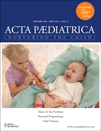Predictive value of body mass index and waist circumference for metabolic syndrome in 6–12-year-olds
Abstract
Aim: To determine the predictive value of body mass index (BMI) and waist circumference (WC) and their optimal cut-off points for metabolic syndrome (MetS), and also the incidence of MetS.
Methods: This study included 888 children, aged 6–12 years, who were followed for a mean of 6.6 years. BMI, WC and their optimal cut-off points to predict MetS were investigated.
Results: The cumulative incidence of MetS was 10.7%. The adjusted ORs for age, sex and family history to predict MetS for BMI and WC z-scores were 2.6 (95% CI, 2.0–3.5) and 2.6 (95% CI, 1.9–3.5), respectively. In their correspondent models, area under the receiver operating characteristic (ROC) curve was 0.73 (95% CI, 0.68–0.79) for BMI z-scores and 0.72 (95% CI, 0.67–0.78) for WC z-scores with no statistically significant difference. The optimal cut-off values for BMI were 16.5 kg/m2 for boys and 16.3 kg/m2 for girls and those for WC were 57.5 cm for boys and 56.5 cm for girls.
Conclusions: Our findings suggest that both BMI and WC have the same power to predict MetS and also children with higher BMI or WC are more susceptible to MetS. Moreover, a high incidence of MetS in children highlights the importance of interventional strategies during early childhood.




